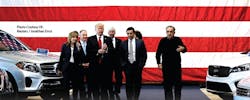What’s Next for the Corporate Average Fuel Economy Standards: Will Trump Roll Back the CAFE?
Last fall, Donald Trump was elected President in part by running on a platform that would deregulate business. One part of this was aimed squarely at the automotive industry, which has remained one of the most heavily regulated industries in the country. Since the election, car makers and their lobbying group, the Alliance of Automobile Manufacturers – which is made up of 12 companies – have called on the administration to reopen a midterm review of the EPA’s Corporate Average Fuel Economy (CAFE) standards.
This is a reaction to the 2016 move by the Obama administration’s Environmental Protection Agency (EPA), which along with the National Highway Traffic Safety Administration (NHTSA), locked in fuel-economy emissions targets for automakers. Under this mandate, automakers would have to achieve an average 54.5 mpg by 2025. CAFE standards, which were first introduced in the United States in 1975, are designed to steadily increase incrementally on certain vehicles through 2025. Currently 35-plus miles per gallon is required for certain 2017 models already in showrooms.
The fuel economy standards were supposed to be reviewed in 2018, but after a brief comment period that ended December 30 of last year, the EPA pushed through portions of the regulations before then President- Elect Trump took office.
The Auto Alliance called for this goal to be revisited, arguing that the move “unnecessarily politicized” the midterm review of the emission standards by moving to finalize the regulations ahead of schedule. In a letter to the new EPA Administrator Scott Pruitt, the Alliance wrote that the “standards threaten to depress an industry that can ill afford spiraling regulatory costs.” The trade group added that 1.1 million jobs could even be lost due to the regulations.
On May 11, Democratic senators also responded to the EPA and urged the agency not to roll back federal fuel-economy standards for cars and trucks. The lawmakers, led by Senator Ed Markey of Massachusetts, have argued that the move could harm consumers and also lead to costly litigation.
In a letter to the EPA’s Pruitt, the 11 senators said the auto emissions standards are, in fact, economically feasible and technologically achievable. The lawmakers wrote, “They will benefit consumers, saving them billions of dollars at the pump and reduce our carbon pollution. It is critical they remain in place.”
The lawmakers further added that the goal of greater fuel efficiency would enhance national security by reducing America’s reliance on foreign oil and added that automakers have thrived under CAFE standards. The senators suggested that 700,000 jobs have been created since 2009 when the more stringent standards were implemented and that sales of vehicles have grown for seven straight years to record highs last year.
Environmental groups have supported the calls by the lawmakers, citing climate and consumer protection.
President Trump has responded by announcing an executive order requiring the EPA to reopen a review of fuel-economy and emissions standards, but how exactly the EPA will respond has yet to be determined.
“It is still hard to say; it is one area where we really won’t know anything until official policy is rolled out,” said Devin Lindsay, principal analyst at IHS Automotive.
“There are calls for the mid-term 2018 review to be put back for evaluation, but we have to wait to see where exactly the current administration is going with things,” Lindsay added.
“Under the original rules, there was a call for a midterm review to see how effective and affordable the technology would be,” explained Dan Welch, solutions fellow specializing in transportation for the Center for Climate and Energy Solutions.
“This commentary period was open until 2018, but the EPA finalized the rules in early 2017, and it should be stressed that it was OK for them to do so; the EPA didn’t step outside the bounds in doing so,” Welch said. “In a sense, this was turning the paper in early.”
However, the Auto Alliance has argued that fewer than 3.5 percent of new vehicles would meet the 2025 stringent targets locked in by the Obama administration before he left office.
“Even under EPA’s optimistic estimates, the automotive industry will have to spend a staggering $200 billion between 2012 and 2025 to comply,” Mitch Bainwol, the president of the Auto Alliance, wrote to Pruitt in February.
“It is clear some automakers felt the comment period ended too early and that the voices weren’t heard, including a thorough discussion of the cost effectiveness of this technology,” Welch said.
While 2025 is still eight years away — a long time for most Americans who still too often can only plan for tomorrow — for the auto industry it is practically around the corner.
“It is just two model cycles away,” Lindsay said. “Plans are already in the works; R&D has already been invested. Automakers can’t wait any longer.”
However, it should be emphasized the auto industry doesn’t want to see the standards discarded — perhaps just slowed down so technology can be developed to meet the goals.
“The automakers will continue to make progress towards meeting those standards, and that isn’t going to change,” Lindsay explained. “All the automakers know what they have to do; there is no other option. In the past there have been fines and the manufacturers have paid these when not meeting standards, but that isn’t an option now.”
It is still likely that the Trump EPA, as well as the Department of Transportation — which oversees the NHTSA — may re-open the review process, and in this case, the automakers may be able to adjust the timetable.
It won’t come without a fight, however; one that could result in a new war between the states. California and 12 other states currently have stricter standards for fuel economy; while California has even received a waiver from the federal government that allowed the Golden State to enforce its much tougher standards.
“If the administration teams up with auto companies to weaken these standards or challenge California’s ability to protect its own citizens, the environmental community and I presume the state of California, as well, will sue,” Dan Becker, director of California’s Safe Climate Campaign, told The Detroit News in March. “I think these standards will end up winning the day.”
It should be noted California isn’t pushing for more rigid standards, however.
“California has harmonized its standards with the EPA and NHTSA,” Welch said. “But under the Clean Air Act, California does have the right to keep its own standards, and that could create difficulties for some automakers when they roll out new models. Also, under Section 177 of the Clean Air Act, other states can follow California’s fuel economy standards.”
Senator Markey agreed a pull-back on standards could be a problem, suggesting the auto companies don’t want 50 state standards.
The other issue is automakers must think globally about their products.
“The domestic manufacturers, as well as those in Germany and Japan, are selling around the world,” Lindsay said. “The days of putting out a specific vehicle for one market is a thing of the past. The investment is going to be more costly if you do it that way, so the automakers have to think about the whole world.”
The technology may not be on track for 2025, but it is still moving forward.
“It is safe to say the technology wasn’t available before,” Lindsay said. “But it is getting there, and there will be ways of meeting the regulations. Going backward on CO2 isn’t going to happen. One way or another the automakers are going to reach those standards.”
About the Author

Peter Suciu
Peter Suciu is Michigan-based writer and NOLN freelance contributor who has contributed to more than four dozen magazines, newspapers and websites. He lives in the land of cars not far from one of Henry Ford's estates.
